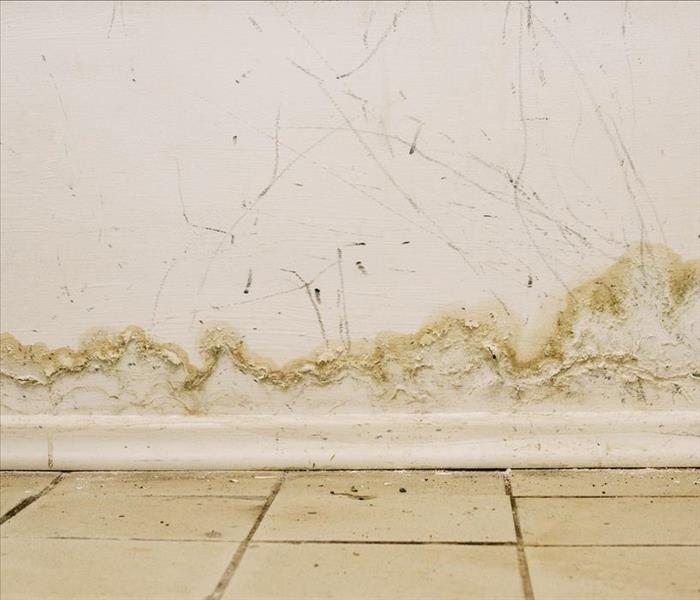I know I need to face my Augusta building’s issue with mold— Who can inspect and help me remove it?
6/17/2020 (Permalink)
 Having mold issues in your place of business? Call the local branch of SERVPRO in your Augusta area to mitigate your mold problem.
Having mold issues in your place of business? Call the local branch of SERVPRO in your Augusta area to mitigate your mold problem.
Mold Inspection and Remediation Services Are a Core Focus of SERVPRO’s Mission to Make It “Like it never even happened,” in Augusta Commercial Buildings
Water damage and mold infestations have a symbiotic relationship in Augusta as they do in any other community. Mold spores are everywhere in the environment, mostly unnoticed as they are tiny and not currently in an active state. When those spores encounter a small bit of water or even high humidity over at least 24 to 48 hours, mold growth is likely.
Can I Rely on My Ordinary Cleaning Crew to Inspect and Manage Mold Effectively?
The issues presented in your Augusta business concerning mold inspection and remediation services likely will recur if specially trained and equipped crews are not in the vanguard of your response efforts. Your regular cleaning crews are probably aware of mold growth and react with non-invasive and short-term solutions. Diluted bleach formulations are often the product of choice, but they have significant limitations:
- Their most substantial action is usually lightening the mold staining on the surface only
- The active ingredient rarely reaches the full extent of the organisms’ hyphae (branchlike “root” system)
- Their high-water content can push moisture into permeable materials and feed additional mold growth
How Do Trained Mold Remediators Differ from the Average Cleaning Crew?
SERVPRO offers effective and efficient mold inspection and remediation services partially because they dovetail seamlessly into our core water damage restoration services. When our crews arrive to evaluate your mold concerns, we walk in with a professional capability to find and follow the water and moisture trails that lead to potential mold damage. Our Institute of Inspection, Cleaning and Restoration Certification (IICRC)-trained managers and technicians are always on alert for signs of both water and mold damage. It informs every aspect of the services we offer to businesses in our region. We want to help you resolve the problem, not just manage it on every cleaning pass.
What Is the Procedure Used by Properly Trained Mold Remediators?
The Environmental Protection Agency (EPA) developed a research-based protocol for commercial buildings and schools. We employ this protocol in our mold remediation work. Phases of the project unpack as follows:
Locate the Mold Growth
How do we inspect for mold growth?
Although we have access to resources to detect mold growth, we usually start with the building owner or manager’s observations. Once we find the signs (staining, visible mold colonies, and musty smells), we investigate how extensive the mold invasion is by checking for wet building materials using tools like moisture detectors and thermal imaging.
Contain the Moldy Area and Affected Materials
How do we contain the area?
Mold spores are lighter than aid and quite dispersible as airborne irritants. They also hold the potential to absorb water in other spaces and start new damage. We contain the workspace with 6-mil polyethylene sheeting attached to framing or a temporary structure to limit the drift of debris and to protect occupants in the building during the remediation. The sealing of the space is reinforced through the use of negative pressure air scrubbing technology, which also captures the airborne debris in HEPA filters before exhausting to the outdoors.
Remove the Mold and Debris
How do we remove the mold?
The primary actions found most effective are mechanical--brushing, scraping, and then vacuuming and wiping up residues. If the mold has infiltrated porous materials, we decide to either cut those materials out and discard them or use abrasive techniques like soda or dry ice blasting to dislodge and disrupt the growth of the organisms.
Apply Antimicrobials
When and why do we use antimicrobials?
In some cases, we apply EPA-registered antimicrobials in a broadcast spray before removal to reduce the airborne load during the project. We do not use the sprays as the only response, but also apply the product to inhibit the mold infestation rebound after removal. Our team is well positioned to offer Certified SERVPRO Cleaned for possible pathogenic presence with our advanced equipment and ongoing training.
Why Does the Remediation Team Wear Personal Protective Equipment (PPE)?
We employ the PPE for two reasons--to protect our technicians and the occupants of the building as we perform the remediation. The care we use when donning and removing the PPE ensures we do not track moldy debris into unaffected areas of your commercial building, safeguarding you, your customers, and your employees.
Discuss your mold inspection concerns with the well-prepared and talented team at SERVPRO of Augusta. Our crews are just one quick phone call away at (706) 750-0200, ready to assess and follow up with proven mold remediation best practices.






 24/7 Emergency Service
24/7 Emergency Service